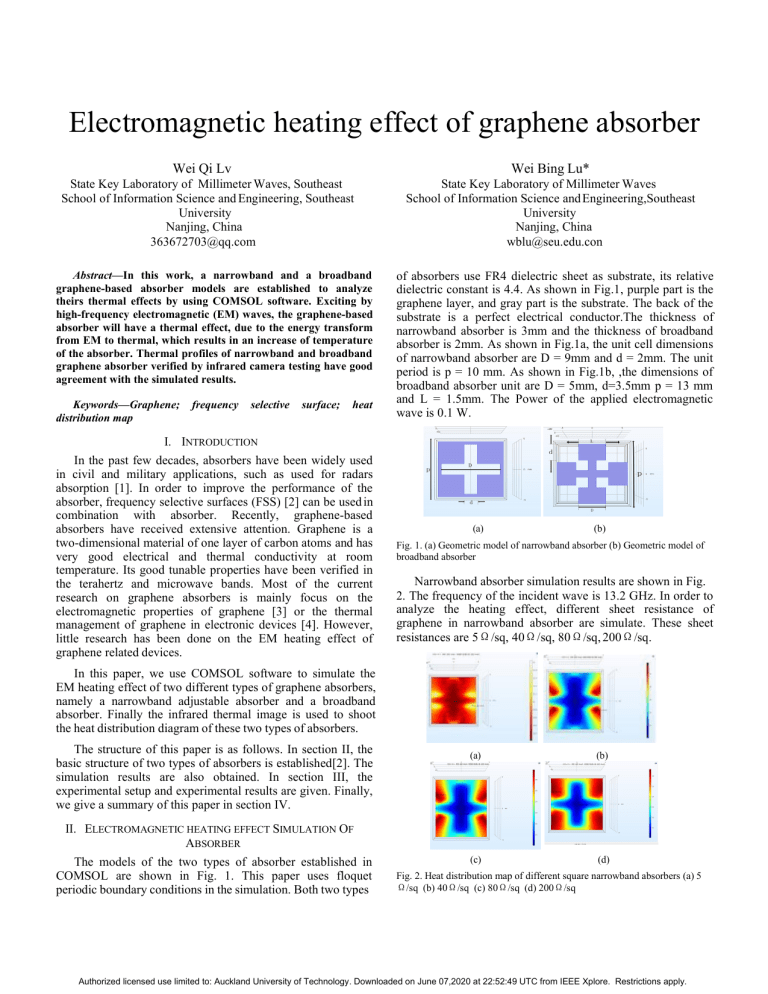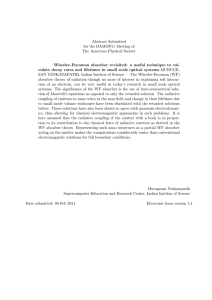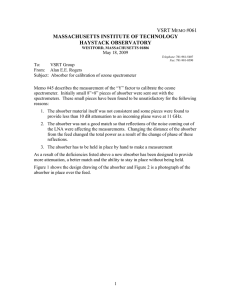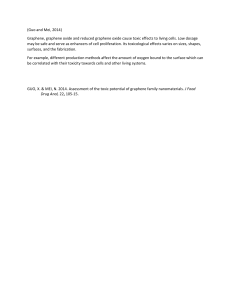
Electromagnetic heating effect of graphene absorber Wei Qi Lv State Key Laboratory of Millimeter Waves, Southeast School of Information Science and Engineering, Southeast University Nanjing, China 363672703@qq.com Abstract—In this work, a narrowband and a broadband graphene-based absorber models are established to analyze theirs thermal effects by using COMSOL software. Exciting by high-frequency electromagnetic (EM) waves, the graphene-based absorber will have a thermal effect, due to the energy transform from EM to thermal, which results in an increase of temperature of the absorber. Thermal profiles of narrowband and broadband graphene absorber verified by infrared camera testing have good agreement with the simulated results. Keywords—Graphene; distribution map frequency selective surface; heat Wei Bing Lu* State Key Laboratory of Millimeter Waves School of Information Science and Engineering,Southeast University Nanjing, China wblu@seu.edu.con of absorbers use FR4 dielectric sheet as substrate, its relative dielectric constant is 4.4. As shown in Fig.1, purple part is the graphene layer, and gray part is the substrate. The back of the substrate is a perfect electrical conductor.The thickness of narrowband absorber is 3mm and the thickness of broadband absorber is 2mm. As shown in Fig.1a, the unit cell dimensions of narrowband absorber are D = 9mm and d = 2mm. The unit period is p = 10 mm. As shown in Fig.1b, ,the dimensions of broadband absorber unit are D = 5mm, d=3.5mm p = 13 mm and L = 1.5mm. The Power of the applied electromagnetic wave is 0.1 W. I. INTRODUCTION In the past few decades, absorbers have been widely used in civil and military applications, such as used for radars absorption [1]. In order to improve the performance of the absorber, frequency selective surfaces (FSS) [2] can be used in combination with absorber. Recently, graphene-based absorbers have received extensive attention. Graphene is a two-dimensional material of one layer of carbon atoms and has very good electrical and thermal conductivity at room temperature. Its good tunable properties have been verified in the terahertz and microwave bands. Most of the current research on graphene absorbers is mainly focus on the electromagnetic properties of graphene [3] or the thermal management of graphene in electronic devices [4]. However, little research has been done on the EM heating effect of graphene related devices. (a) (b) Fig. 1. (a) Geometric model of narrowband absorber (b) Geometric model of broadband absorber Narrowband absorber simulation results are shown in Fig. 2. The frequency of the incident wave is 13.2 GHz. In order to analyze the heating effect, different sheet resistance of graphene in narrowband absorber are simulate. These sheet resistances are 5Ω/sq, 40Ω/sq, 80Ω/sq, 200Ω/sq. In this paper, we use COMSOL software to simulate the EM heating effect of two different types of graphene absorbers, namely a narrowband adjustable absorber and a broadband absorber. Finally the infrared thermal image is used to shoot the heat distribution diagram of these two types of absorbers. The structure of this paper is as follows. In section II, the basic structure of two types of absorbers is established[2]. The simulation results are also obtained. In section III, the experimental setup and experimental results are given. Finally, we give a summary of this paper in section IV. (a) (b) (c) (d) II. ELECTROMAGNETIC HEATING EFFECT SIMULATION OF ABSORBER The models of the two types of absorber established in COMSOL are shown in Fig. 1. This paper uses floquet periodic boundary conditions in the simulation. Both two types Fig. 2. Heat distribution map of different square narrowband absorbers (a) 5 Ω/sq (b) 40Ω/sq (c) 80Ω/sq (d) 200Ω/sq Authorized licensed use limited to: Auckland University of Technology. Downloaded on June 07,2020 at 22:52:49 UTC from IEEE Xplore. Restrictions apply. Similarly, we choose different sheet resistance of graphene in broadband absorber to simulate the heating effect. These square resistances are 5 Ω/sq, 20 Ω/sq, 50 Ω/sq, 70 Ω/sq. The applied electromagnetic wave frequency is 13.2 GHz.The result of the simulation is shown in Fig. 3. (a) First, we measure the heat distribution of narrowband absorber. In order to compare the effects of different sheet resistance of graphene, we put the narrowband absorbers with two sheet resistance of graphene together for imaging the heat distribution, on the left is 40 Ω/sq, and the right is 5 Ω/sq. The specific placement method and measurement results are shown in Fig. 6. (b) (b) Fig. 6. (a) narrowband graphene absorber placement method (b) Thermal imaging camera measurement results (c) Similarly, we measure the heat distribution of broadband absorber with square resistance of graphene 20 Ω/sq and 70 Ω/ sq . The measurement results of the infrared camera and placement method are shown in Fig. 7. (d) Fig. 3. Heat distribution map of different sheet broadband absorbers (a) 5 Ω /sq (b) 20 Ω/sq (c) 50 Ω/sq (d) 70 Ω/sq It can be seen from the simulated results that in the excitation of 13.2 GHz electromagnetic wave, The absorber produces a thermal effect. The heating effect is due to the conversion from electromagnetic energy to heat energy. Refer to the microwave absorption rate for absorbers with different sheet resistances of graphene in Ref [3]. From the figure, It can be observed that the absorbers with different sheet resistances have different absorbing rates. Therefore, the heat distribution of the devices are different. The relationship between the absorbing rate and the frequency is shown in Figure 4. (b) (b) Fig. 4. Absorption coefficients of the narrow absorber (b) Absorption coefficients of the broadband absorber (b) Fig. 7. (a) broadband graphene absorber placement method (b)Thermal imaging camera measurement results According to the experimental results, it was confirmed that graphene was heated when receiving high frequency microwaves energy and transforming it into thermal energy. In Figure 4, it can be found that different square sheet absorber have different absorbing rate. Simulations and experiments have confirmed that the absorbers with different absorbing rates have different heat distribution map. IV. CONCLUSIONS In this paper, we simulated the electromagnetic heating effect of two different absorbers. Through the simulation of COMSOL software, we obtained the heat distribution diagram of the graphene-based absorber with different resistance. Finally, the heat distribution diagram of the absorber was taken using an infrared camera. REFERENCES III. EXPERIMENT The method of measuring the heat distribution of graphene-based absorbers is to use infrared camera, flir T250, and a free space microwave device, as shown in Fig. 5. [1] [2] [3] [4] (a) (b) L. J. Du Toit, “ The design of Jauman absorbers, ” IEEE Antennas Propag. Mag., vol. 36, no. 6, pp. 17–25, 1994. PD. Yi, X.-C. Wei, and Y.-L. Xu, “Tunable Microwave Absorber Based on Patterned Graphene, ” IEEE Trans. Microw. Theory Techn, vol6. no .8, pp. 2819-2826, Aug. 2017. Hao Chen, ,Wei-Bing Lu. Zhen-Guo Liu, “Experimental Demonstration of Microwave Absorber Using Large-Area Multilayer Graphene-Based Frequency Selective Surface,” in IEEE on Microwave and TechniQues, vol. 66, No.8 , pp. 3807–3816, Aug. 2018 Zhong Yan, Guanxiong Liu, Javed M. Khan, “ Graphene quilts for thermal management of high-power GaN transistors, ” nature communications, vol. 3, no. 827, pp. 1-8, May. 2012. Fig. 5. (a) Free space microwave device (b) infrared camera flir T250 Authorized licensed use limited to: Auckland University of Technology. Downloaded on June 07,2020 at 22:52:49 UTC from IEEE Xplore. Restrictions apply.





